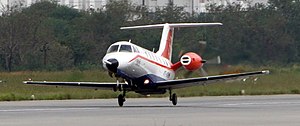NAL Saras
| NAL Saras | |
|---|---|

|
|
| Type: | Short-haul airliner |
| Design country: | |
| Manufacturer: | |
| First flight: |
May 29, 2004 |
| Number of pieces: |
2 prototypes |
The NAL Saras is a short-haul airliner under development by the Indian aircraft manufacturer Hindustan Aeronautics .
development
Originally the NAL Saras was a development of the Russian design office Myasishchev under the designation M-102 Duet. Myasishchev carried out extensive wind tunnel tests with models. Models with Gluschenko TWD-20M or Pratt & Whitney Canada PT6A-66 Turboprop engines were presented. A 1: 1 mock-up was exhibited at MAKS 2015 , which differed from the models in that it had a nose landing gear with only one wheel instead of two wheels as before. After a long development phase, the Russian design office brought in the Indian aerospace company due to financing problems and turned the aircraft into a joint project. Eventually the Russians dropped out of the project entirely. The rest of the development work was carried out by the Indian National Aerospace Laboratory (NAL). She has set herself the goal of getting the Saras ready for series production. The project is struggling with significant time and weight problems. The first prototype (PT1) took off on its maiden flight on May 29, 2004 after a long delay. A second prototype (PT2) followed in April 2007. It was lost in a crash on March 6, 2009, and the two pilots and an engineer were killed. It turned out that the aircraft was too heavy and more powerful engines had to be used. The flight control systems were also seen as in need of improvement. The development was then temporarily stopped. NAL resumed work on the program in 2016 by modifying the first prototype. It received new engine nacelles, improved landing flaps and rudders as well as new cabin equipment. The prototype, now known as PT1N, made its first flight after the renovation on January 24, 2018.
The planned 19-seat series version (Mk2) is to be significantly lighter, with improved flight controls and new avionics elements. Two PT6A turboprops are planned as engines, which should enable a range of 800 km and a speed of over 500 km / h.
construction
The NAL SARAS is a twin-engine low- wing aircraft with two propeller turbines and a T-tail unit attached to the side of the pylons at the stern . The two engines are designed as so-called pushers (= with thrust propellers), which results in a reduction in noise in the cabin.
The aircraft should be able to take off and land from hot and high-altitude airfields with unprepared runways. Different variants are planned: short-haul passenger aircraft, air ambulance and surveillance aircraft.
Technical specifications
| Parameter | Data |
|---|---|
| crew | 2 |
| Passengers | 15th |
| length | 15.02 m |
| span | 14.07 m |
| height | 5.17 m |
| Wing area | 25.70 m² |
| Max. payload | 1232 kg |
| Empty mass | 4116 kg |
| Max. Takeoff mass | 7100 kg |
| Max. Cruising speed | 625 km / h |
| normal cruising speed | 520 km / h |
| Service ceiling | 9000 m |
| Range with max. payload | 1200 km |
| Engines | two propeller turbines Pratt & Whitney Canada PT6A-66 with 1170 kW each |
Web links
- Center for Civil Aircraft Design and Development. Development department on the website of CSIR-National Aerospace Laboratories, India
- Sara's Duet Saga
Individual evidence
- ^ Jefim Gordon , Sergei Komissarow: Unflown Wings Soviet / Russian unrealized aircraft projects 1925-2010. Ian Allen Publishing, pp. 383-384, ISBN 978-1-906537-34-0 .
- ↑ a b Piotr Butowski: Aero India 2019 - Airscene . In: AIR International April 2019, p. 37
- ↑ Indian pusher plane takes off again , accessed on February 28, 2018